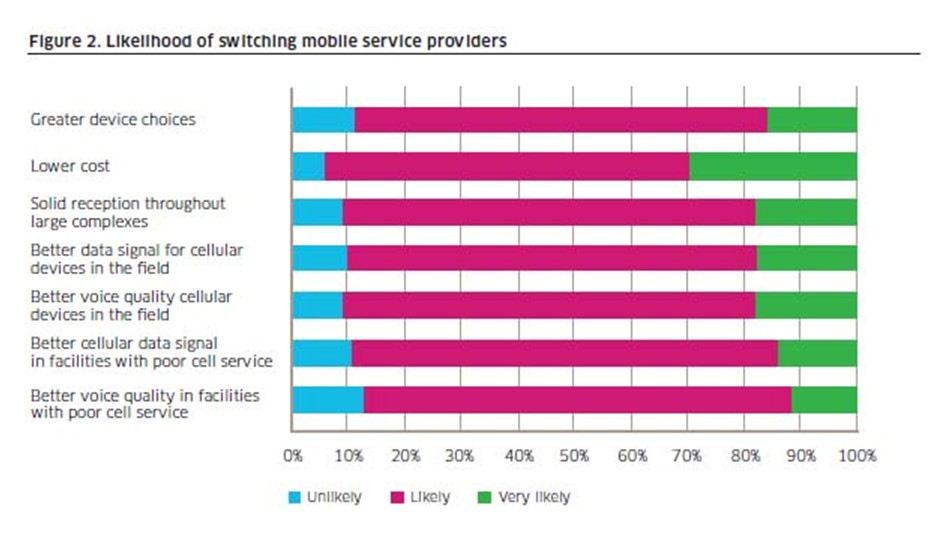This article originally appeared in the Sept. 2012 issue of Next Gen Mobility.
As you look around the office, are there clusters of people huddled by windows talking on or trying to access info from their mobile device? Are you one of those battling to make themselves heard above everyone else in a small corner of mobile coverage in the building? Or do you simply go outside to access your data and make your calls?
Room for Improvement
The proliferation of mobile devices available on the market today has driven a dramatic increase in demand for mobile broadband. With it now possible to stream video and access high-bandwidth data applications on the move, consumers and business subscribers alike are expecting more from their mobile provider outside and inside the office – wanting higher speeds and higher quality connections. The consumption of huge amounts of bandwidth is stretching operators’ cellular networks to capacity, affecting call quality and the customer experience.
In the office there is an added constraint. With mobile signals unable to penetrate deep into the building through the walls, the reason so many people are huddled by a window is because it’s the only area they can receive mobile coverage. The further inside the building you go, into meeting rooms and stairwells, the less coverage you can get – and often it’s the operator, not the building that is blamed by subscribers.
In-office Cellular Performance is Key in Carrier Selection
A recent survey of IT executives from businesses of all sizes in the U.K., Italy, Spain, Brazil, Russia, Singapore and Australia, commissioned by Alcatel-Lucent (News  - Alert), showed that at the right price and with guaranteed performance, many employees prefer to use their mobile device in the office. However, there is little loyalty to service providers when faced with poor mobile broadband coverage inside the office.
- Alert), showed that at the right price and with guaranteed performance, many employees prefer to use their mobile device in the office. However, there is little loyalty to service providers when faced with poor mobile broadband coverage inside the office.
Many of the companies surveyed said they had a contract with more than one mobile service provider. But with voice and data performance in the office as important as in the field, more than 87 percent said they would switch service providers to receive improved cellular coverage and performance.

Small Cells Bring the Customer Closer
Small cells provide operators with an effective solution to the problem. A small cell is a mini base station, no larger than a standard Wi-Fi router, which can be set up within an office or home environment as well as a highly populated or remote area, to extend a service provider’s cellular network and improve performance and quality for subscribers.
A small cell for enterprise or business use delivers crystal clear voice and high-speed, business-grade mobile broadband services to employees’ mobile devices deep within the office building to improve the customer experience. Employees and their devices are brought closer to the base station, so less power is used and less time is spent charging the device. With no gaps in coverage, subscribers experience smooth streaming of videoconferences, without drops to voice calls or delays in providing customers with that all important data they need right now.
Being plug-and-play, an enterprise small cell doesn’t require any specialist knowledge, and a business or individual can install it themselves. This, combined with their small size, means that businesses can install them anywhere in the office without being faced with additional set-up charges.
Once set up, the cell is ready to provide high-quality, high-speed broadband to nearby mobile devices.
Creating a Mini Private Network
To avoid no-go areas in a larger office space, or to support a large number of employees, multiple cells may be required. To allow employees to move across the office without dropping a call, each cell needs to recognize another to create a small network.
This challenge can be addressed with self-organizing network algorithms – a Bell Labs (News - Alert) innovation that ensures that as each cell is installed it automatically recognizes another to form a small optimized network. With no need for specialized engineer knowledge, this helps keep network deployment costs low and makes sure there are no dropped calls anywhere.
The small cell will recognize all subscribers of its associated service provider in its vicinity if access is left open. A company can take extra measures to ensure that only employees, not visitors, can use the cell. Access can be made private, by registering mobile devices to the cell, left open, allowing anyone within range to benefit – or a mixture of private and open access can be defined, allowing registered devices priority with remaining capacity open to all.
In addition to improved coverage, an enterprise small cell makes it possible for a mobile service provider to offer new services, based on information within the cell itself as it recognizes a mobile device. Businesses could set up automatic text notifications with the latest team information or even the restaurant’s dish of the day. As employees enter the office and the vicinity of a cell, they will receive the news via text. Defining access permissions means visitors don’t have access to the news too.
Relieving Strain from the Cellular Network
As small cells act as dedicated base stations, mobile traffic is taken off an operator’s cellular network. Therefore, as coverage and quality are improved for those subscribers using the small cell, the reduction in traffic over the cellular network relieves demand and means an improved quality of service for all other subscribers too.

Meeting Demand with Improved Coverage and Quality
Demand for greater coverage in the office is clear. The survey conducted by Alcatel-Lucent showed that 72 percent of respondents would be interested in small cells, with 43 percent being highly interested. An enterprise cell provides the answer to this demand, delivering a low cost-solution for both operators and businesses to improve mobile broadband coverage and quality in the office. Easily installed by anyone, without any engineering or optimization experience, small cells reduce the costs traditionally associated with deployment. As traffic is removed from the main cellular network, the mobile broadband is improved for all subscribers.
In the office environment, small cells allow employees to move away from the window and walk around the building, into meeting rooms, down stairs and into the restaurant making sure a conference call is no barrier to buying lunch.
Crystal clear quality and higher speed data connections lead to an improved mobile broadband experience for all in the office and, as shown from the recent survey, leads to even greater customer loyalty.
Edited by
Braden Becker  QUICK LINKS
QUICK LINKS 






